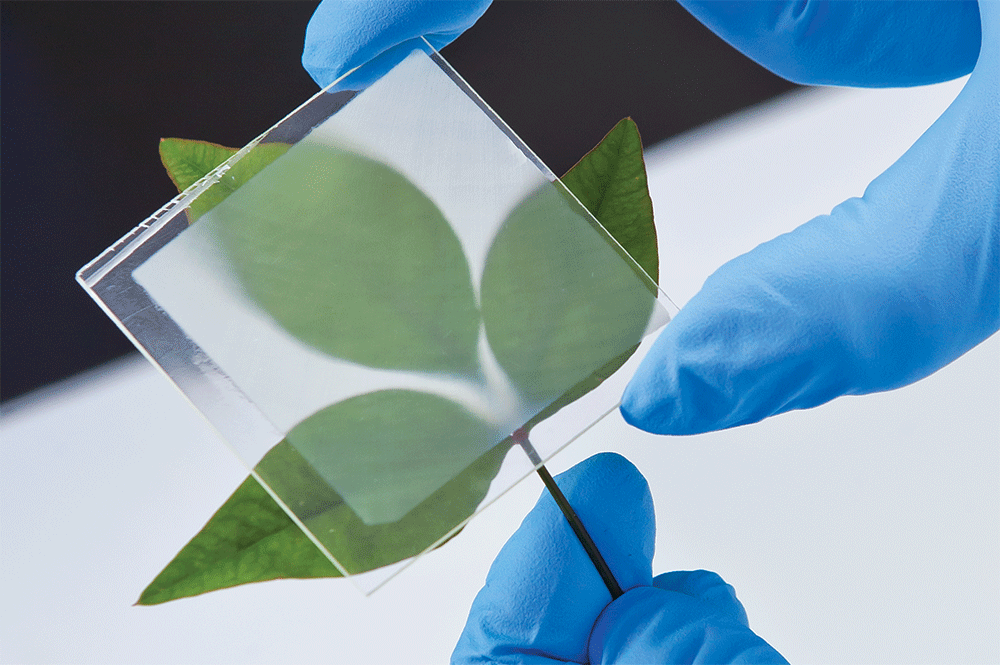 |

|
 |
Hu and team's innovated wood is uniformly transparent and has many potential applications. Photo by John Consoli. |
|
What if we told you that wood can be used to make a smart window that is more energy efficient and provides more consistent natural light than glass?
Transparent wood has been developed and patented as a building material by Liangbing Hu, associate professor of materials science and engineering, and his research team at the Clark School. Now, Hu and his team are taking the next step in developing this innovation by using the material in collaboration with the University of Maryland's Solar Decathlon team. For the first time ever, transparent wood will showcase its functionality not only as an energy efficient and cost-reducing material, but also as a visually appealing skylight.
Transparent wood is an exceptional material. Tian Li (Ph.D. '15, electrical engineering), the lead researcher on Hu's team, explains that compared to glass, transparent wood is lighter, stronger, has better thermal insulation, and is light guiding. The process of creating transparent wood involves removing lignin, which is what gives wood its brown color. The modified wood is refilled with an index-matching polymer to make it transparent. The final product is waterproof, biodegradable, and energy efficient. Additionally, unlike glass, which shatters from impact, transparent wood is stronger and can absorb higher impact energy.
Sabrina Curtis (M.S. '18, materials science and engineering) and Alan Murphy (M.S. '19, materials science and engineering) work under Hu as master's students. Inspired by a colleague who was involved with Solar Decathlon in 2005 and 2007, they reached out to the current team with their vision on a potential collaboration. Murphy, dedicating his master's study to the process and applications of transparent wood under his postdoc advisor Li, will be helping to make the skylight for UMD's Solar Decathlon 2017 team.
According to the research team, the application of the transparent wood in the Solar Decathlon team's house is two-fold. It will serve as a visually appealing skylight to allow for natural lighting, while also thermally insulating the attic. The transparent wood composite allows the visible wavelengths of sunlight to pass through, but absorbs infrared and ultraviolet rays that carry heat. The attic must maintain extreme temperatures to ensure proper heat distribution to the rest of the house. This skylight will guide light into the house independent of the position of the sun, which means the light that fills the room will be more consistent and more comfortable to look at during all hours of daylight. The skylight will also provide a competitive edge to the Solar Decathlon team.
"I think that this will be one of the most unique skylights in the Solar Decathlon competition," Curtis said. "It's showcasing the innovation and research that's done at the University of Maryland, and it's also allowing a university team to be the first one to show a transparent wood window."
Transparent wood, as the UMD Solar Decathlon team will demonstrate, offers real world applications as a window and roof. Hu's team is excited to show off research conducted at UMD and demonstrate that their prototype can have a practical application. They hope this collaboration will bring the Solar Decathlon team research, innovation, and style points in the competition this fall.
"Besides aesthetic appeal, the application of transparent wood can potentially help cut daytime lighting and air conditioning energy usage towards the goal of energy balancing in the house," Li said. "As the combined effort between the research group and Solar Decathlon team, the project is the realistic application of transparent wood as energy efficient building material and will help transform this fearless idea to new innovations that potentially can benefit millions."
May 30, 2017
|

